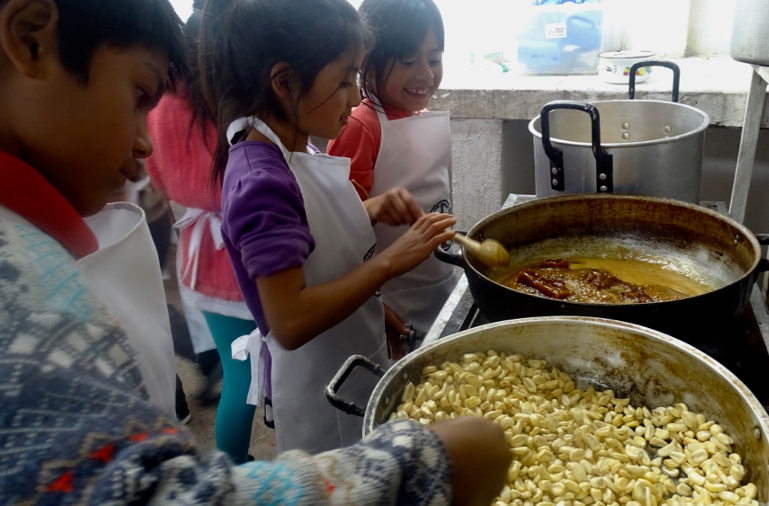QUILLOAC, Cañar, Ecuador — The mountain valleys are greener now than they were in the hacienda days. The people walk, drive, ride, and dance with more hope and joy. Crops come in, businesses grow, and new construction is everywhere. The community is connected electronically to every part of the world. Education is universal in Spanish and in Kichwa, and many people are fluent in English. Things are looking up. But the people of the Kañari community in Southern Ecuador know they have a long way to go. They also see what’s lacking. They still seek environmental equilibrium.
The Kañari people look at their children and watch them grow. For each child to reach maximum physical and intellectual potential, they know that good health is essential. Good nutrition, good diets, good habits that last a lifetime must be formed early. Many forces, influences, and pressures work against this.
A well-nourished child learns better, thinks better, interacts with others better. And good nourishment comes from healthy soil, comes from fresh air and sunlight, comes from the nutritious grains, tubers, and vegetables that have fed the Kañari people for thousands of years. A well-nourished child knows the joys of a communal meal that includes quinua, potatoes, locally grown vegetables that he or she can identify by name and feel and smell. These children engage in loud laughter and spirited play. These children are the hope for the Kañari future.
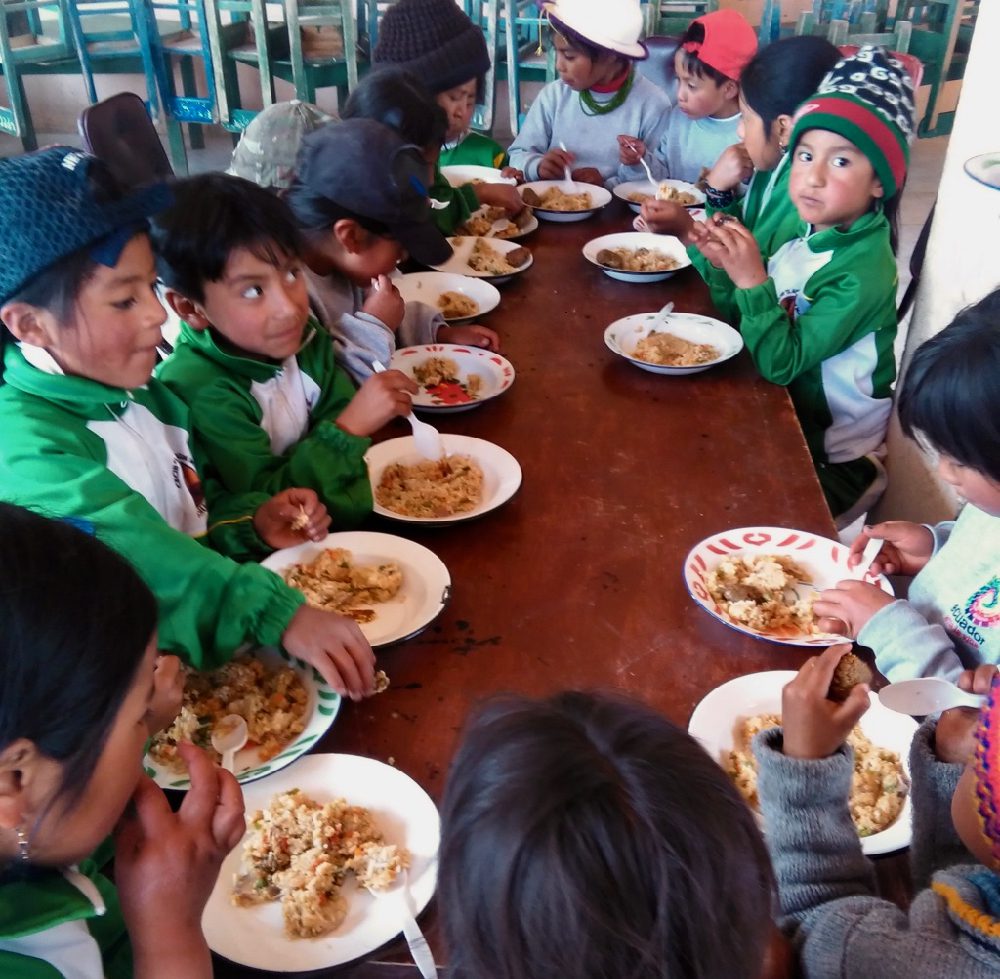 Kañari children enjoy a communal meal with some of their traditional foods.
Kañari children enjoy a communal meal with some of their traditional foods.
There is malnutrition at varying levels and to varying degrees among the children. It is recorded, but the statistics are not up to date or complete. There are diseases related to malnutrition that the school nurses are well aware of. These diseases slow the children down. There are also cases of lack of energy, of children not learning to their potential, and of delayed development. Can these be corrected by better nutrition?
Unlike the United States, the nation of Ecuador provides adequate breakfasts and lunches to all children without regard to economic status of the family. To do otherwise would be totally absurd to the people of Ecuador. But, the meals provided by the national food service have been shown to be inadequate, unhealthy, and unappetizing. I contacted an Ecuadorean nutrition researcher who demonstrated this, Irene Torres, and invited her to look at the alternative developed in the Kañari territory by the Kañari people. We’re just getting started.
The alternative meal program was launched about 20 years ago. La Asociación de Productores de Semillas y Alimentos Nutricionales Andinos Mushuk Yuyay (The Association of Producers of Seeds and Nutritious Andean Foods Mushuk Yuyay) came up with the idea and began to implement it on a very limited scale. It has been plodding along, little by little, ever since. They call it Niños Saludables y Futuro Saludable. In English I called it Healthy Children, Healthy Future. It needed a Kichwa name – Yuyaysapa wawakuna alli kawsay.
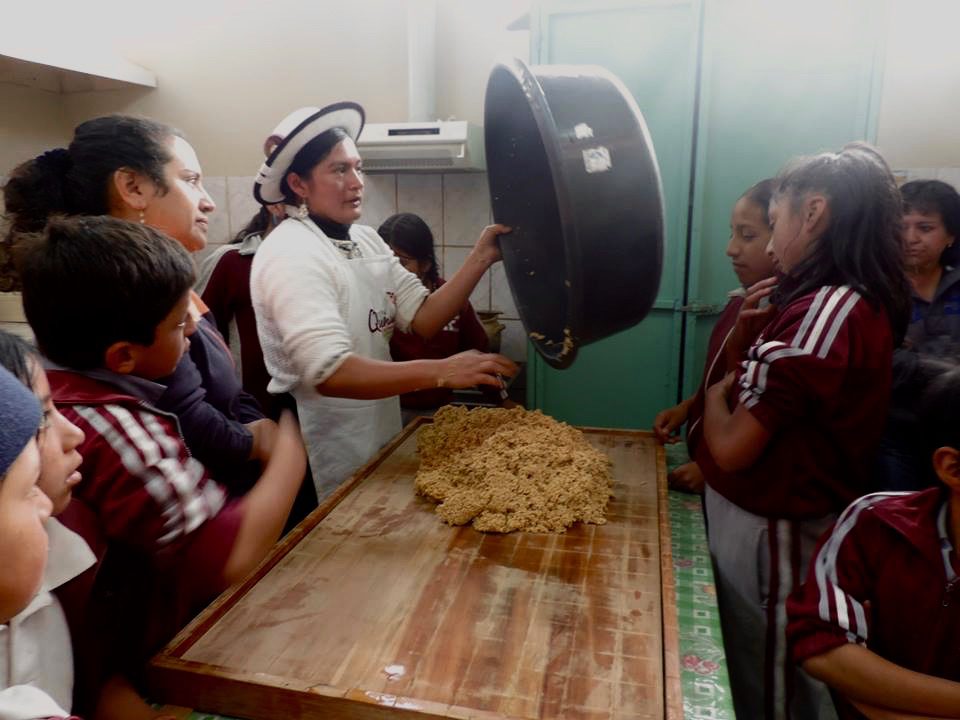
Program nutritionist Lucinda Duy with a group of students.
Depending on resources available, the intervention takes a variety of forms. If the school has a demonstration plot, the children plant the nutritious traditional crops under the direction of the Mushuk Yuyay agronomist and learn about the food values from the Mushuk Yuyay nutritionist. School nurses record the children’s growth and wellbeing throughout the program. With their teachers, the children learn the science of plant growth and development. Children then watch the plants mature and become ready for harvest. They take the foods from field to plate with the direction of teachers, nutritionists, and parents. Children cook, present, and taste the foods, and then evaluate the whole process. Through the reporting stage, children practice writing and speaking skills. Children appear on public media and at festivals where they explain what they have done and advocate healthy diets to the public.
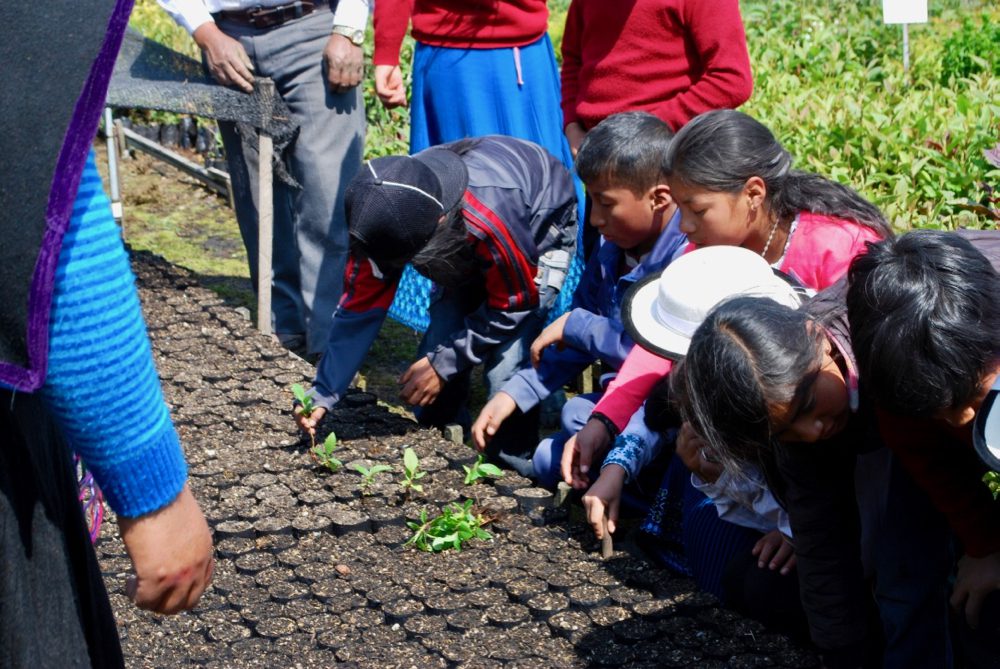 Local farm production has been diminishing in recent years. The Healthy Children program seeks to restore regional food sovereignty, beginning with the children.
Local farm production has been diminishing in recent years. The Healthy Children program seeks to restore regional food sovereignty, beginning with the children.
There are many programs throughout the world involving school gardens that include children in the work and supply healthy and fresh foods to the schools. They take a wide variety of forms and accomplish many goals. What sets Healthy Children, Healthy Future apart are three main aspects of the project. One, it is community-sponsored and community-driven. Two, it addresses a wide variety of issues facing people. And three, it is aimed at building a better future for the community. It can be argued that other programs address some of these issues, but I do not know of one that combines all of these into its goals.
The Kañari community recognized the need for healthy and active learners. They struggled to establish schools in the first place at the time of the agrarian reform in the 1960s and 70s. Now they need students who can benefit maximally from the educational experience. They recognized that local farm production was diminishing due to emigration of much of the labor force. Fields were turning to pastures. Men who had emigrated had found jobs and were sending home cash. Caretakers, be they mothers or grandparents, didn’t have time or resources to prepare complicated traditional meals of Andean grains and tubers that they didn’t harvest from the fields beside their houses. Inexpensive and easy-to-prepare foods were available from the stores down the street. Besides, the children learned from their televisions and from their friends to ask for these commercial foods by name. They want to grow up eating what the modern children eat. Grandparents won’t say no. Even mothers get worn down. Smiles brighten the faces of children, even though their health and school performance are suffering.
The Kañari community designed and implemented the intervention to address this issue. The government didn’t see the need. They had a contract with a company to supply food. Outside entities had no interest in supporting an unproven idea.
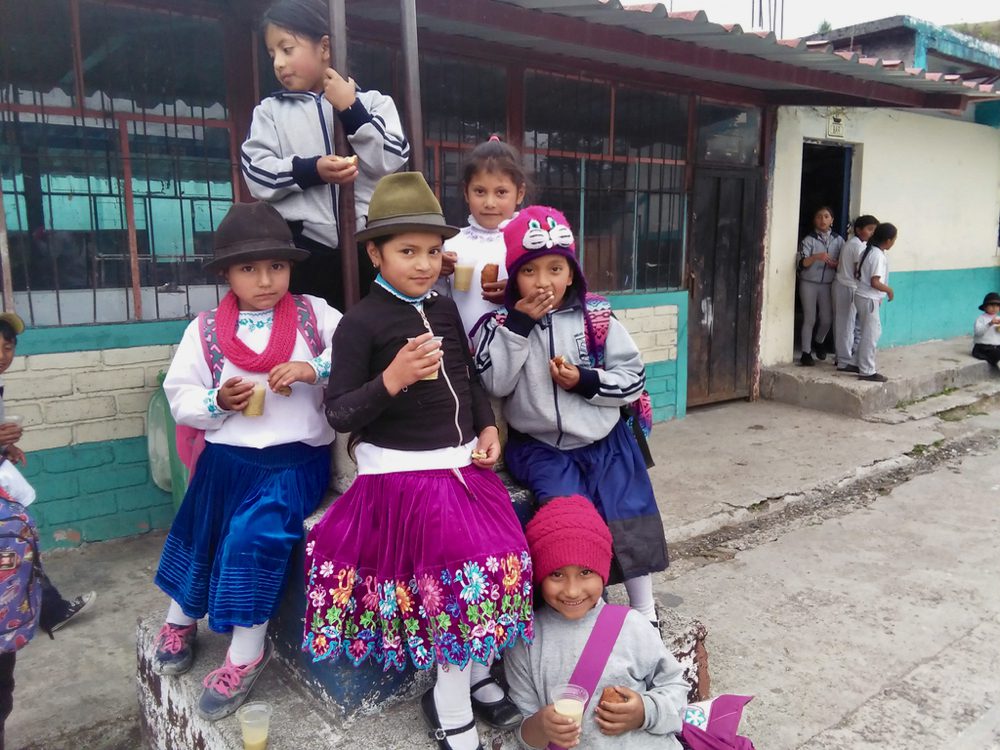 A group of happy participants, some in their native dress, in front of their school.
A group of happy participants, some in their native dress, in front of their school.
The second aspect that sets this program apart is that it is designed to solve the very problems in all of their manifestations that made the program necessary in the first place. It is easy to say that children should eat fresh foods grown locally. That is true. But why isn’t this food consumed already? We need to strengthen local crop production. Heathy Children, Healthy Future not only produces its own food, but it creates a demand to be supplemented by food grown on local farms. The program provides a small market. This market will continue if children develop a taste for local foods and learn to ask for them by name. Increased markets will, slowly, encourage increased planting, converting pastures into fields again. Crops produced using agroecological methods prevent carbon from leaving soils as well as pulling excess carbon from the atmosphere. Mushuk Yuyay is removing carbon from the air, one molecule at a time, mitigating climate change.
We have to start somewhere. Increased farming production increases availability of farm products in the markets. Increased production and marketability raises incomes and, in a small way at first, lessens the need for emigration. And, of course, the program produces healthy children.
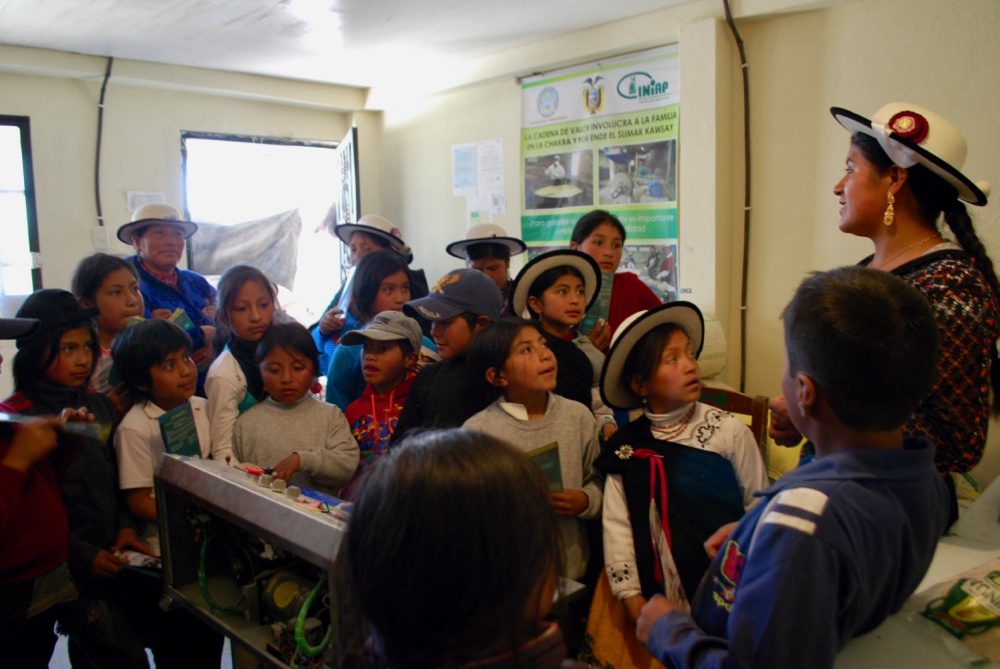
The enthusiastic participation and from the reports the children have given show that the program is effective in getting them to eat well and feel good about it.
The third aspect of this initiative is that it strongly addresses the future. The children are the hope of the community to continue to exist and thrive as it has for thousands of years here in the high mountains two degrees south of the equator. In order for the children to guarantee a future for the community they must grow healthy bodies and minds, be prepared for maximum cognitive development in the school, participate in the culture and traditions of the community, and, most of all, be in the community as adults to raise another generation and be the next elders. Good students, strong and healthy children, are valued community members. Participation in the learning and the activities of Healthy Children, Healthy Future insures that they internalize the values of eating from the place where they live, the home of their ancestors. As the children learn to value local agriculture, they find a place to make their futures within the homeland. Farming and related industries are strengthened so that there will be employment.
Will this program have a lasting impact? We know from the enthusiastic participation and from the reports the children have given that the program is effective in getting them to eat well and feel good about it. That, alone, makes it worthwhile. Now we need to follow up with the same children to see if they continue to choose healthy diets. We need to observe whether their health continues to be improved. And, we need to monitor within the community to see whether they continue to encourage other children to ask for nutritious foods at mealtime. We need to evaluate within the community how to improve, expand, or intensify the program. The Kañari people invented the program and they are implementing it, as well as modifying it, to resolve issues as they see them. They will next evaluate with community and professional input to decide the next move.
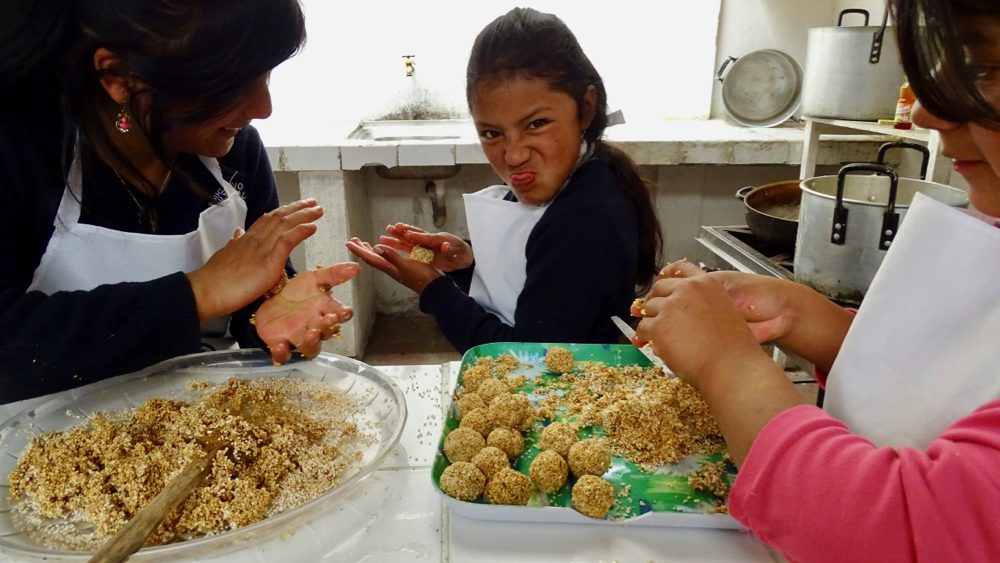
One of the program’s funding sources is through production, including handmade amaranth snacks. Here a playful child mugs for the camera while making an amaranth treat.
A Healthy Future is the goal. A plan is in place to make that possible. Right now the program depends on sparse contributions from local and national government entities, one NGO that is no longer in existence, but, mostly, from returned Peace Corps Volunteers who see the value of a Healthy Future. Individuals have contributed, the Boston Area Returned Peace Corps Volunteer group, the Returned Peace Corps Volunteers of New Jersey, and Friends of Ecuador. Stu Moskowitz, a Returned Volunteer, is the one who convinced me to work with the Returned PCV community. I didn’t know about them.
For future financing, Mushuk Yuyay is developing a funding source of its own. The group is producing amaranth snacks for sale locally, and beginning to collect money. These snacks also provide a healthy alternative for local children in school and out. A local women’s farming association is using seed sent as gifts from Guatemalan and Mexican farmers to diversify the amaranth varieties. Individual contributors and Friends of Ecuador helped the nutritionist, Lucinda Duy, to attend El Primer Congreso Mundial del Amaranto (The First World Amaranth Conference) in Puebla, Mexico, to learn more about growing, processing and marketing amaranth. Now the association is searching for ways to purchase equipment to process the crops much more efficiently. Lucinda also made a presentation about Healthy Children, Healthy Future while she was attending the Congreso.
 Program nutritionist Lucinda Duy (left) with the poster they made to present Niños Saludables y Futuro Saludable to the First World Amaranth Conference in Puebla, Mexico.
Program nutritionist Lucinda Duy (left) with the poster they made to present Niños Saludables y Futuro Saludable to the First World Amaranth Conference in Puebla, Mexico.
Mushuk Yuyay is using its new processing center inaugurated last year to produce and package the snacks. Their newly earned Certificate of Health from the Ecuadorian Department of Health makes it possible for them to supply the snacks to the children.
Just last month Mushuk Yuyay welcomed a new collaborator, Isabel Rodrigues, who is helping to develop new quinua products that can be marketed to promote more healthy eating. Sales of these products will also be used for Healthy Children, Healthy Future as well as to promote more quinua cultivation. Kevin Murphy of Washington State University brought in new lines of quinua for more trials, and, at the same time, brought Isabel Rodrigues along to introduce her. The collaboration has been dynamic.
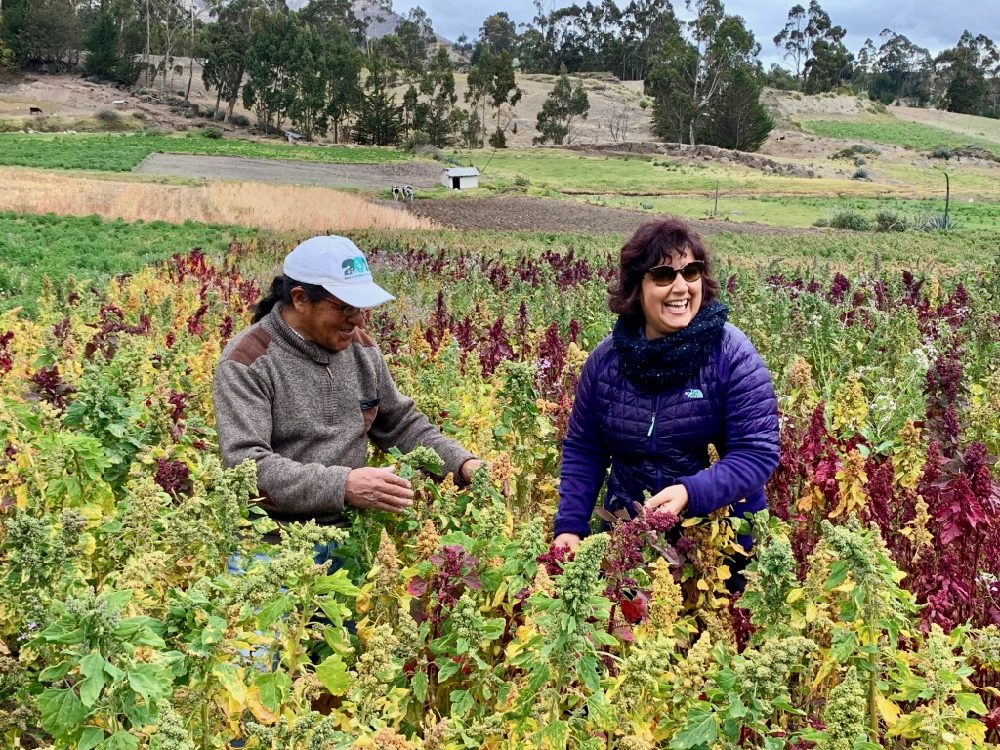
Mushuk Yuyay co-founder Nicolás Pichazaca, on the left, in the field, evaluating promising quinoa lines at Wasington State University with Isabel Rodrígues, a new contributor to the Healthy Children, Healthy Future program.
Without a doubt, Healthy Children, Healthy Future will grow as resources become available. Communities throughout the area are asking for the program in their schools. There is never a problem with the intervention being welcomed into the schools. The local officials are enthusiastic supporters and the teachers are welcoming collaborators because of the demonstrated effectiveness of the program. We just need two things: researchers in the area of nutrition to back up our success story with hard data, and money. Of course, money is needed for pots, pans, fuel, salaries, seed, fertilizers, instructional materials, and extra food that cannot be grown in the school plots. We have detailed budgets. The money is invested back into the community economy, and everyone benefits.
Nutrition education is one way that the Kañari people can put their children into a better world than the one they inherited. Not only will the world be moving toward better balance, the children will be prepared to continue and further that movement. The generation before inherited a degenerated environment; they tried to sustain what they had without losing ground. Then the present generation worked to restore the land and the ecosystems to a functioning world where Pachamama can seek balance. Now it is for the children being brought up in a healthy environment and learning to build on the successes of the current adults, to discover the way to establish a regenerative environment. Then, the Earth can heal and give each succeeding generation a better place to live.
Healthy Children, Healthy Future: two essential ingredients that depend on each other for the Kañari community to thrive.
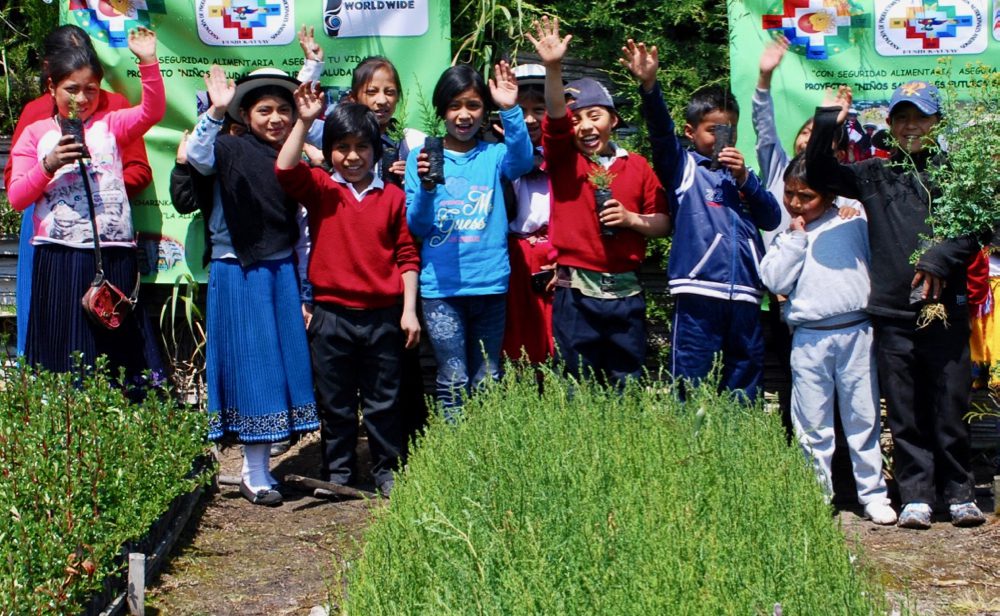 Feature photo: Children in the forestry nursery holding up their little trees.
Feature photo: Children in the forestry nursery holding up their little trees.


